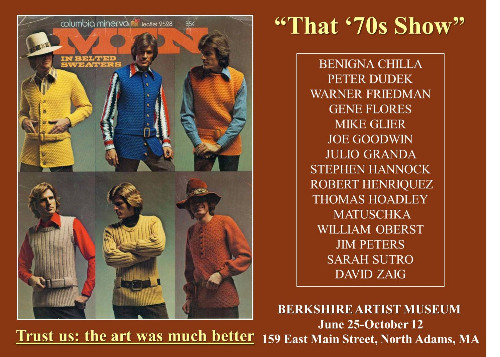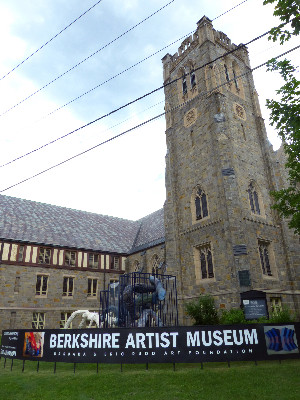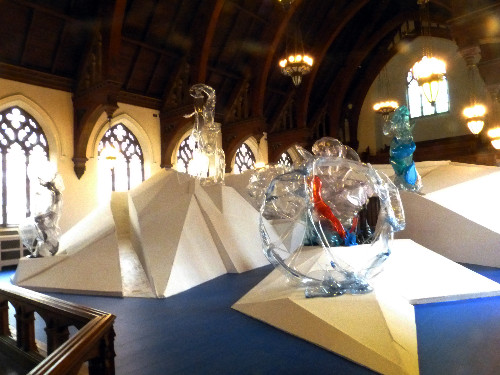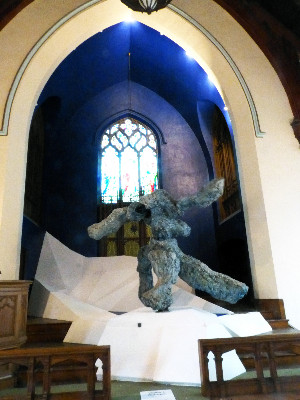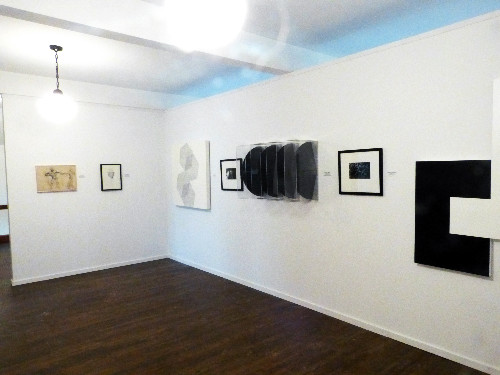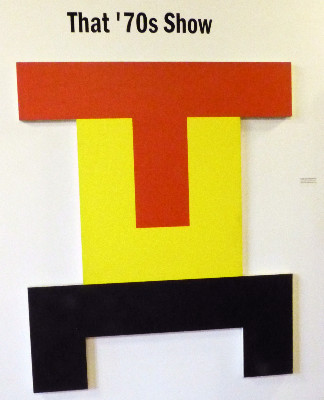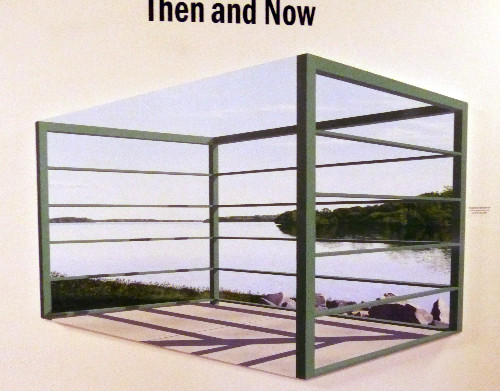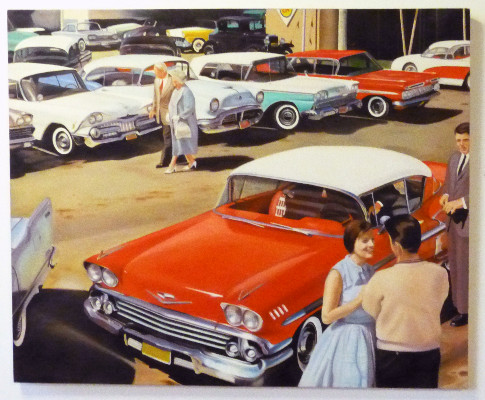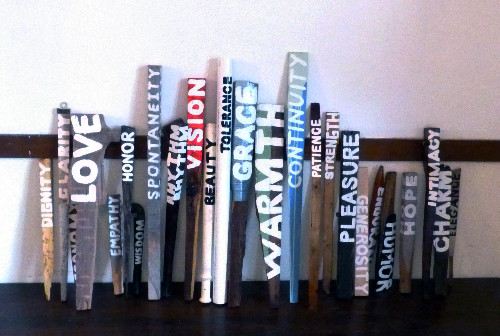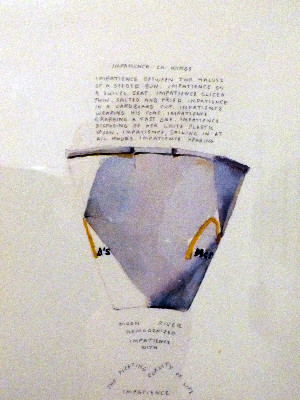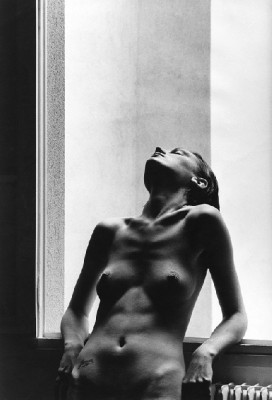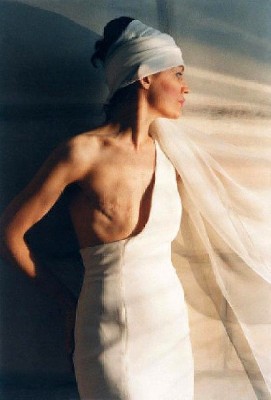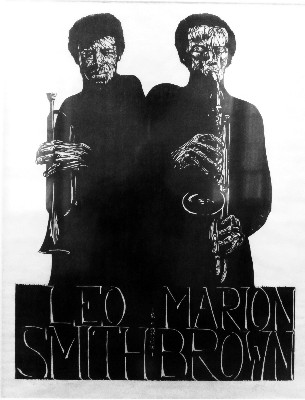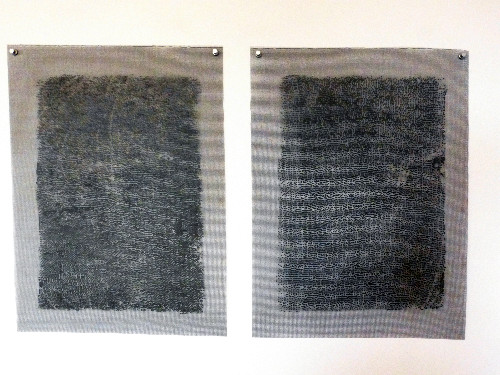Berkshire Artist Museum
Featuring Work by Eric Rudd and Regional Artists
By: Charles giuliano - Jun 28, 2015
That ‘70s Show
Part one of Then and Now
Curated by Keith Shaw
Artists: Benigna Chilla, Peter Dudek, Warner Friedman, Gene Flores, Mike Glier, Joe Goodwin, Julio Granda, Stephen Hannock, Robert Henriquez, Thomas Hoadley, Matuschka, William Oberst, Jim Peters, Sarah Sutro and David Zaig
Permanent collection of work by Eric Rudd, ongoing.
Iceberg, an installation by Rudd, world premiere
Berkshire Artist Museum
159 East Main Street
North Adams, Mass.
June 25 to October 12
Last summer the artist/ developer and now mayoral candidate, Eric Rudd, launched phase one of a long term overview of his work in the former First United Methodist Church. It opened as the Rudd Art Museum.
With the start of the 2015 season and revised strategy for its long term growth RAM has been renamed as Berkshire Artist Museum. This suggests broader programming of regional art in addition to the permanent collection of works by Rudd.
What was shown in the galleries devoted to a retrospective of Rudd’s work remains the same. That phase is now complete with the opening of the nave and its Iceberg installation which provides a multi-valent platform for his period of large plastic sculptures. The Lexan pieces were created with the facilities and materials of General Electric in Pittsfield.
In discussions with the artist he described working quickly and fluently with the molten but fast hardening material. The process is balletic evoking the image of Jackson Pollock in ritual dances around a canvas spread out on the floor
Under then director and current chief curator, Keith Shaw, there were upper level galleries in the tower of the former church showing the work of regional artists.
That has expanded somewhat with a greater increment of space for a Then and Now project of which part one That ’70s Show is now on view. Later in the season the second phase will be revealed in the first of the suite of lower level galleries. Currently, that space exhibits Rudd’s earliest works as an emerging artist in Washington, D.C. The gallery includes reconstructed, large, polychromed minimalist sculptures. The sculptures will remain but Shaw will hang current works by the 15 artists in the ‘70s show.
Like most senior artists Rudd is in that phase of his career when steps must be taken to assure its creative legacy. Within walking distance is an earlier Rudd project in a former church The Chapel for Humanity. In the Beaver Mill which Rudd owns there was a former installation The Dark Ride. Some years ago Eric and Barbara Rudd founded The Contemporary Artists Center in the Beaver Mill. That moved to Troy, New York when former mayor John Barrett blocked attempts by then CAC director, Hezzie Phillips, to relocate the organization to a church. That property has since been acquired by MCLA.
Two of the artist in the ‘70s show, Robert Henriquez and David Zaig, were participants in the CAC project. Astrid Hiemer and I first came to North Adams as guests of CAC. Later we bought a loft in the Eclipse Mill which Rudd developed as artist studios.
In founding the Berkshire Artist Museum, as well as the Chapel for Humanity, the artist drew upon his own resources. The founding of museums devoted to the work of a single artist is not unprecedented. The norm is to preserve the work of artists who have had significant careers with sufficient monetary resources.
While Rudd enjoyed periods of success in his career, and the support of a renowned curator, Walter Hopps, he does not have gallery representation and in recent years has rarely exhibited other than in spaces that he owns. There does not appear to be an established market for his work. Selling work from estates is the usual manner in which museums dedicated to a single artist are sustained.
This is a common problem for the legacy of artists. If the artist does not establish a significant exhibition history and market value during his or her career it is unlikely that will occur through heirs and trustees. Rudd, in fact, has written a book on that subject “Strategies for Serious Older Artists.”
By establishing an initially self titled museum Rudd appears to be taking his own advice.
After one season, with input from a dynamic board of directors, it is apparent that for long term survival it is unlikely to fund a museum of just his work.
Using Mass MoCA as an example it is more viable if the exhibition space and programming is approximately fifty percent permanent collection and fifty percent changing exhibitions. It also takes diverse programming; lectures, performances, openings, readings and other special events to bring visitors back to the museum.
That ‘70s Show is a step in the right direction. To make this concept work and to attract a sustainable audience and funding for BAM it will be essential over the next several years to open up more exhibition space. A workable equation demands at least 50% of annual changing shows of regional artists.
Involving artists within a fifty mile radius would make BAM a more viable museum. There are many possibilities for creating dynamic programming including collaborations with neighboring museums.
Those close to the project strongly feel that BAM has the potential to be the Fourth Museum in the Northern Berkshire as a vital ally with Mass MoCA, The Clark Art Institute and Williams College Museum of Art.
Visitors to the region want to know about local and regional artists. BAM is a more upscale asset to the efforts of the annual Downstreet. It anchors one end of a lively gallery run.
To reach that level and initiate programming compatible with these established museums BAC will have to focus on development. The lighting in the galleries, for example, is a holdover of its use as a church.
Development of the nave as a setting for the Iceberg proved to be expensive and not entirely successful. I have been a fan of Rudd’s Lexan series of sculptures. A couple of years ago he invited guests to view them in a vast studio in the Beaver Mill. They were stunning in that space. A couple of these works were included in the exhibition of his work which I curated for the gallery of the New England School of Art & Design at Suffolk University.
The Iceberg installation does not enhance the sculptures and is actually a distraction. The complicated structure disrupts the architectural integrity of the neo Gothic interior. This is further exacerbated by the floor now painted a bright blue as ersatz water. The space might better have been used to mount the large sculptures on low pedestals. A modular approach would allow for different curatorial configurations of the space in years and decades to come.
On the altar area, next to the pulpit and in front of a beautiful stained glass window, is Rudd’s amorphously shaped, monster/ giant. It is a robotic work which lurches about and inevitably makes one think of a pastor preaching to the objects perched on the glacial flow in front of it.
For a period of time, Shaw, who teaches art history at Berkshire Community College, covered galleries and alternative spaces for the Berkshire Eagle. Museum level exhibitions were reviewed by Charles Bonenti who is now retired but continues to contribute the occasional piece.
The reviews by Shaw were much appreciated by the arts community. Not having them is a terrible loss. He was not replaced by another qualified critic. Pieces are either written by the Shires supplements editor, Kate Abbott, or by general assignment reporters. They are not qualified to cover the visual arts.
Given the importance of the arts and a culture based economy, including world class museums and artists in the region, the lack of professionalism for fine arts criticism is deplorable.
As a colleague I respect but do not often agree with Shaw. We have very different views of contemporary art.
Trying to explore and write about his concepts for The ‘70s Show is confounding. It implies that the critical mass of 15 artists and 40 works have been selected from artists he knew and covered during his time of writing for the Berkshire Eagle.
But his thesis for the project and what he thinks about these specific artists is a matter of conjecture.
Shaw insists that this is a “Museum level thematic exhibition” and not just another “group show.” That comes with certain assumptions. It is the norm when writing about museums that they provide materials to the media. Often there is a press conference, tour of the exhibition with the curator and staff, as well as an opportunity to ask questions or conduct interviews. Usually special lectures and panels are presented as part of the educational initiative of the museum.
It is standard for the curator to write an essay in support of the exhibition. The PR staff provides access to high resolution images, a press release, check list of works and artist biographies.
Despite our request for information none of this was made available by Shaw. He explained that it was not necessary to require these materials. As an Eagle critic, as he told me, Shaw made a point of never speaking to or being influenced by an artist or curator. Reflecting his training he was able to speak to the work of art. That is indeed impressive but when possible I have preferred to treat the artist or creator as a valued primary source. It is not a matter of having the work “explained” but rather being able to probe more deeply into the intentionality.
I don’t know what Shaw’s theoretical take on the ‘70s consists of. It was a diverse and dynamic time for American artists. In the 1980s there was a project for several Boston museums to jointly curate “Aspects of the ‘70s.” The resultant catalogues became an identically formatted boxed set. In 1981 the New Museum’s “The 1970s: New American Painting” was organized by Allan Schwartzman, Kathleen Thomas, and Marcia Tucker. It was sponsored by the United States Information Agency (USIA) and traveled to Italy, Denmark, and Eastern Europe.
Left to our own deductions it appears that Shaw’s show represents a selection of artist he encountered in the Berkshires. One assumes that he admires their work and asked if they had examples from the 1970s.
Considering that they are showing works from some forty years ago that’s a very generous gesture on their part. Since one assumes that their work was still forming that exposes them to risk and misunderstanding. Some artists have been known to buy back and destroy their early work.
So it is intriguing to see examples that have survived. Since I have not covered Shaw’s beat I was not familiar with all of the artists.
Because of pride of place in the installation one assumes that Shaw believes that Warner Friedman is the most important of the selection of artists. Based on “then” I do not agree and I have not seen enough of the “now” to form an adequate evaluation.
The several examples of his geometric abstraction and “the shaped canvas” did not compare favorably with better know artists of that approach. It is interesting that in the Rudd galleries there are similar examples of hard edge abstraction.
By centering Friedman’s work it is out of sync with what hangs next to it. There is an apples and oranges disharmony with Joe Goodwin’s super realist “Ok Used Cars” 1974. Realism was a major development in the 1970s in works by Richard Estes, Jack Beal, Al Leslie, Philip Pearlstein, Robert Bechtle and others. The Goodwin painting is an outstanding example of that sensibility.
It was fascinating to see the woodcut “Leo Smith and Marion Brown” by Stephen Hannock. Today he is represented by Marlborough Gallery and is included in major museum and private collections. I have spent a lot time in Hannock’s studio and published extensive interviews about the work.
The stunning and now very rare print comes from when Hannock was close to Leonard Baskin a master of the medium of woodcut which his work strongly resembles. There was another component that Hannock had access to some amazing jazz musicians from Archie Shepp to Max Roach who were professors at U. Mass in Amherst.
Right from the first steps of his career Hannock had unique relationships with key mentors, including art historians the sisters Mongan, as well as collectors who allowed him to focus on his work. After, that is, abandoning an early ambition to be a professional hockey goalie.
There are a number of interesting and wonderful works in this exhibition.
The early works by Benigna Chilla, now retired from BCC, are particularly compelling. I know her works through visits to her home for social gatherings. She has had a number of important exhibitions in the past couple of years but they have been out of our range for visiting. These seminal pieces reveal her career sustaining interest in aspects of post Bauhaus and Russian Avant-garde constructivism. There is vibrant, three dimensional patterning that activates the eye of the viewer in the manner of Op art. But its conception and execution is more complex and engaging. This is work that we would love to see more of.
The early work by Mike Glier in this exhibition proved to be enervating and off putting. There was an awkward display of crude, found clubs which the artist apparently acquired for self defense. These blunt force instruments have been flipped with words of love and peace painted onto them. In another work there are multiple, black and white stills from a video of the artist dancing with his wife Jenny Holzer. Perhaps influenced by her use of text there is a word attached to the array of similar images. I look forward to seeing more recent work by Glier in the Now phase of the project.
Matuschka, an artist who uses a single name professionally has lived and worked in the Berkshires. In 2013 she had an exhibition at Sohn Fine Arts in Stockbridge. Before that I spent time in her New York apartment trying to talk with her to the accompaniment of a pissed off screeching parrot. Based on that experience I wrote a piece called Parrot Fever.
Apparently, Shaw has yet to meet Matuschka and the single piece, a head shot, was delivered by another exhibiting artist, Peter Dudek. I am posting another work with better resolution of her nude photography from the 1970s. She is most famous for a single 1993 image reproduced on the cover of the New York Times Sunday Magazine.
Dudek is a partner in Bascomb Lodge on Mt. Greylock. He was formerly director, following founder Maggie Mailer, of the Storefront Artists Project in Pittsfield. He is known for complex sculptural installations. This show includes photographs of early pieces by the artist including “Wards Island” 1977-79.
For me the most astonishing and richly satisfying work in the ‘70s show is a large, exquisitely executed, brilliantly colored deconstruction of the ubiquitous bar code by Robert Henriquez. It is indeed a museum level piece.
It is both Then and Now. It is a single work that covers both ends of the forty year span. The work was conceived in the 1970s but at the time the artist, an employee of CBS News, lacked the resources and technology to realize his concept. It would be sensational to see twenty of his recent works created on the scale and quality of this single example.
Works by the Haitian born artist have been included in shows which I curated. Also I have written extensively about his work including when it was shown in a Haitian project for Gallery 51 of MCLA.
David Zaig is also an artist whom I have shown and written about for a number of years. That started when he asked me to write an essay for his solo show at Boston’s Copley Society. He was included in multiple venue shows I organized on the themes of portraiture and dynamic approaches to landscape.
The early piece in this show reveals his career long interests in the polarities of airbrushed super realism and conceptual abstraction. As Zaig often states “thinking” is an essential aspect of his process. The works in the show combine stencils which form vectored layering of space.
Today Sarah Sutro is known for abstract paintings and the use of natural dye which she experimented with during years of living in the Far East. Here we see early combinations of abstracted water color forms combined with hand written text.
The 1977 painting by Jim Peters “Sublimation Reentry” is remarkable in the degree to which it resembles works that he showed at the Eclipse Mill Gallery last year. It indicates that he reached a mature style rather quickly which he has continued to refine. He is an artist with an extensive exhibition history who fairly recently relocated from Provincetown.
In general it takes a long time for realist painters to master their craft. It was fascinating then to see the early efforts of William Oberst one of our most respected and widely shown Berkshire artists.
Until phase two and more examples of the work I will reserve comments on Gene Flores, Julio Granada and Thomas Hoadley.
This exhibition creates anticipation for Then and Now later in the season. At that time it will be inviting to revisit and enjoy the early efforts of these artists.

